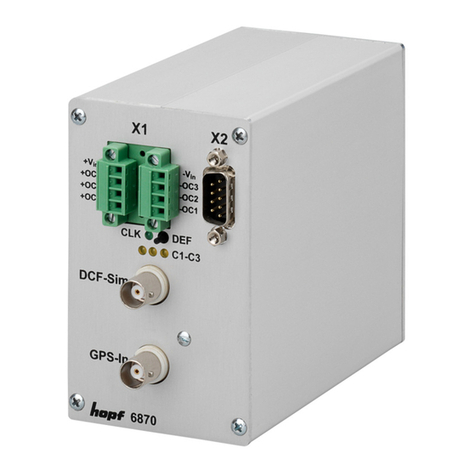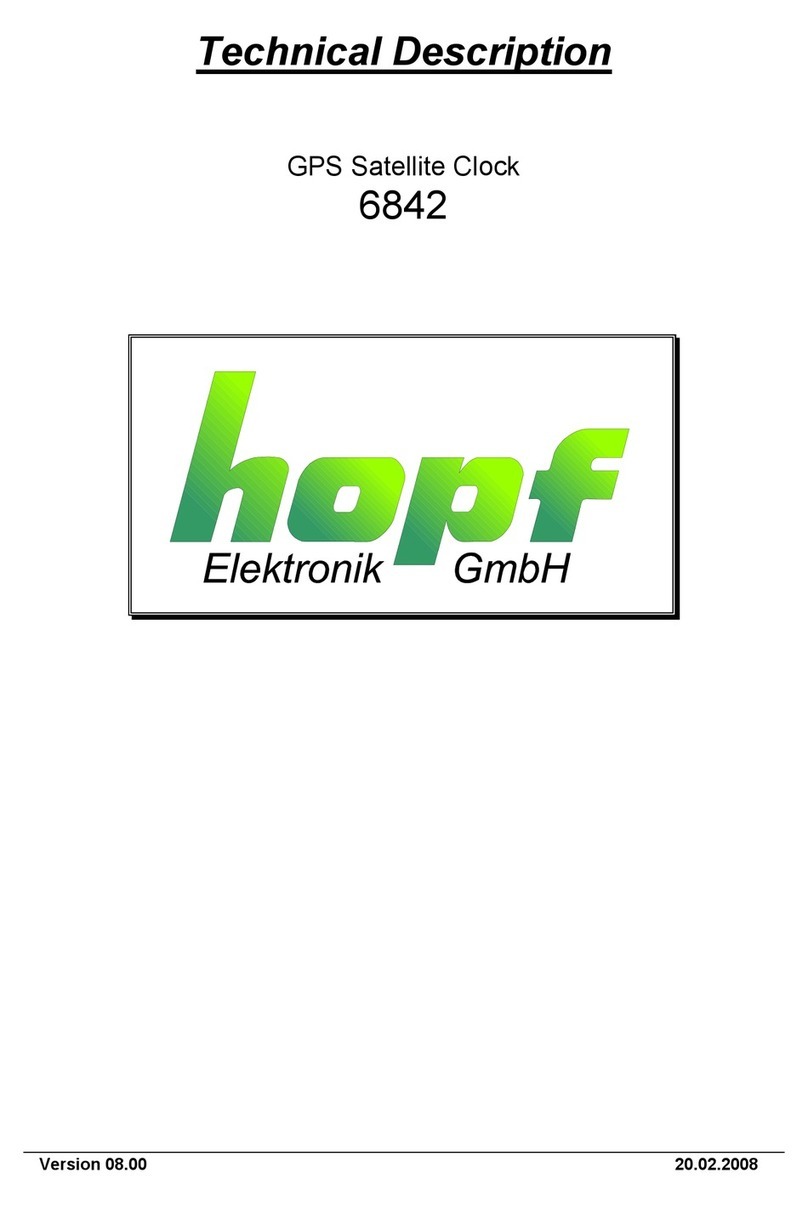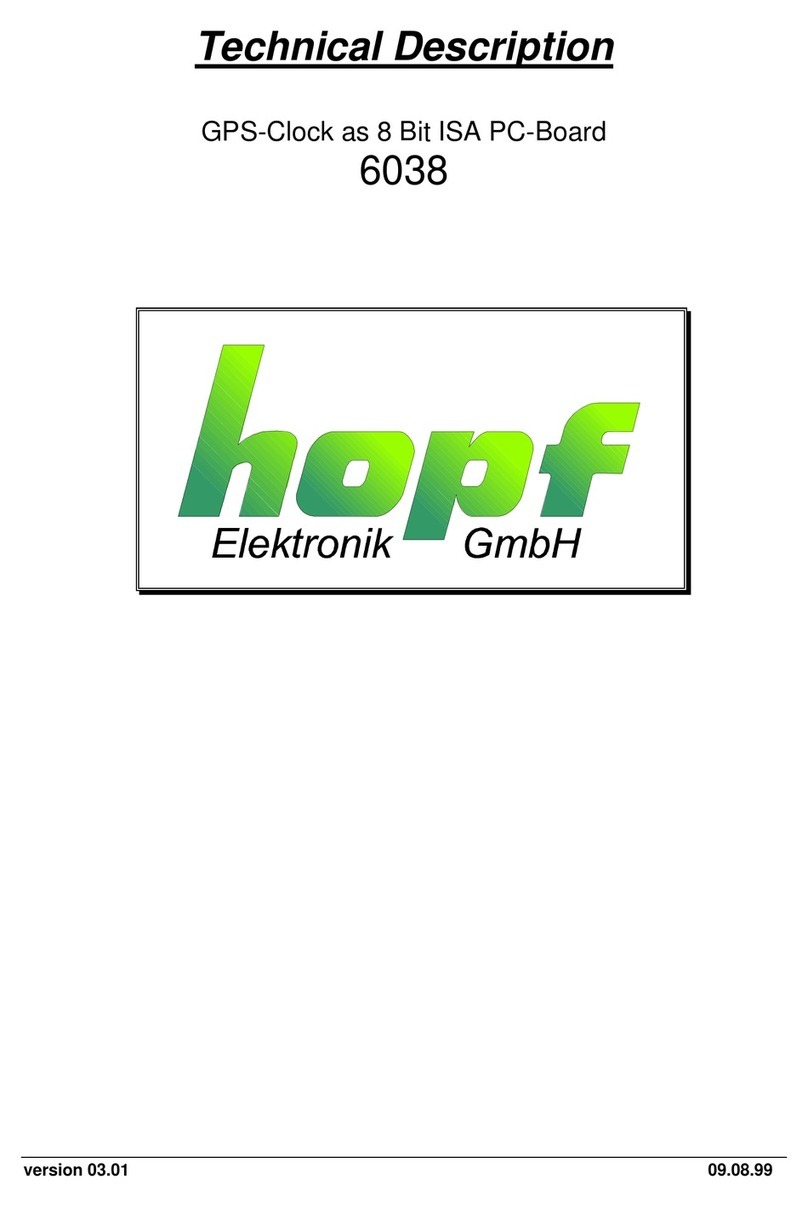
TABLE OF CONTENTS
Multi-Source Function System 7001RC - V02.01 5 / 31
hopf Elektronik GmbH
Nottebohmstr. 41
•
D-58511 Lüdenscheid
•
Tel.: +49 (0)2351 9386-86
•
Fax: +49 (0)2351 9386-93
•
Internet: http://www.hopf.com
•
Contents Page
1Multi-Source System - General...................................................................................... 7
1.1 Functional Schematic of a Multi-Source System......................................................... 7
1.2 Fundamental Problems of Multi-Source Systems ....................................................... 8
1.2.1 Status Information as a Component of Time Transfer......................................................... 8
1.2.2 Time Zone / Time Difference to UTC ................................................................................... 8
1.2.3 Summertime/Wintertime Changeover (ST/WT changeover) ............................................... 8
1.2.4 Leap Second ........................................................................................................................ 9
1.2.5 Automatic / Manual Changeover between the Sync. Sources ............................................ 9
1.2.6 Time Leaps when switching between two Sync. Sources ................................................... 9
1.2.7 Unification of the different Time Information ........................................................................ 9
1.3 Difference from a Safety System .............................................................................. 10
2Multi-Source System based on System 7001RC ....................................................... 11
2.1 Principle of the hopf 7001RC Multi-Source System ................................................ 11
2.1.1 Differentiation between Sync. Source Status and System Status ..................................... 12
2.1.2 Differentiation between Primary and Secondary Source ................................................... 12
2.1.3 System Behaviour on Automatic Source Changeover....................................................... 13
2.1.4 Example of System Behaviour on Changing Status of the Sync. Sources........................ 13
2.2 Display of the Synchronisation Status in the 7001RC System Display..................... 15
2.3 Configuration of the Multi-Source System................................................................. 16
2.3.1 Automatic / Manual Source Changeover ........................................................................... 16
2.3.1.1 Status Table for Automatic Source Changeover......................................................................... 17
2.3.2 Adjustable Multi-Source Modes ......................................................................................... 18
2.3.2.1 Multi-Source with GPS (Channel 1) and Master/Slave-String (Channel 3) ................................. 18
2.3.2.2 Multi-Source with DCF77 Pulse (Channel 2) and Master/Slave-String (Channel 3) ................... 18
2.3.3 Delayed Changeover between Primary and Secondary Source ....................................... 19
2.3.4 System Behaviour on Summertime/Wintertime Changeover ............................................ 19
2.3.5 Configuration of the Master/Slave-String Time Base......................................................... 20
2.3.5.1 Local Time as the Time Base in the Master/Slave-String (Standard) ......................................... 20
2.3.5.2 UTC as the Time Base in the Master/Slave-String ..................................................................... 20
2.4 Synchronisation Signal Requirements ...................................................................... 21
2.5 Sync. Source Requirements ..................................................................................... 21
2.6 Special Features in the System Behaviour ............................................................... 22
2.6.1 System Behaviour on Sync. Source Changeover.............................................................. 22
2.6.2 Behaviour on ST/WT Changeover ..................................................................................... 22
2.7 Connection of the Synchronisation Channels ........................................................... 23
2.7.1 GPS - Channel 1 ................................................................................................................ 23
2.7.2 DCF77 Pulse - Channel 2 .................................................................................................. 23
2.7.3 Master/Slave-String - Channel 3........................................................................................ 24
2.8 Synchronisation Process........................................................................................... 24
2.8.1 Synchronisation via GPS (Channel 1) ............................................................................... 24
2.8.2 Synchronisation via DCF77 Pulse (Channel 2) ................................................................. 25
2.8.3 Synchronisation via Master/Slave-String (Channel 3) ....................................................... 25
2.9 Error Messages......................................................................................................... 26
































